 In their new book “The Healthy Home: Simple Truths to Protect Your Family From Hidden Household Dangers”, authors Dr. Myron Wentz and Dave Wentz share how modern living has helped to contribute to hidden household dangers. Here are just 10 tips from their book that you may want to adopt as part of your daily living.
In their new book “The Healthy Home: Simple Truths to Protect Your Family From Hidden Household Dangers”, authors Dr. Myron Wentz and Dave Wentz share how modern living has helped to contribute to hidden household dangers. Here are just 10 tips from their book that you may want to adopt as part of your daily living. 1. When the weather permits, open the windows.
The cummulative effects of pollutants such as carpet glue, paint, cleaning agents, finishes on furniture and its fabrics can be harmful. When you have a chance, open the window and let in some fresh air. Even on the worst day of air quality OUTSIDE, the air inside your home may be 5 times as bad!
2. Reconsider using those CFL lightbulbs.
They may be good for the planet but if they break, they release mercury vapor which is toxic. When you dispose of them, can you imagine how many break while being handled by the people who dispose of your garbage?
Besides, I have yet to see any of the ones that I’ve used outlast an ordinary lightbulb. Simply using a lower wattage lightbulb will help.
3. Don’t cook on teflon.
Teflon releases hazardous fumes and particles into the air. Not only that, but the ones that I have purchased (and they were expensive) have peeled….which means, I’ve been EATING teflon. The authors recommend cast iron.
4. Buy clothing and bedding made from natural fibers such as cotton and well…hemp.
Synthetic fibers are made from all sorts of artificial chemicals that are too long to list. The one I was most surprised about is that cotton-poly blends are often treated with formaldehyde! Some clothing has PFCs which are linked to reproductive toxicity and bladder and liver caner.
Anything labeled static-resisitant or wrinkle resistant is suspect.
(Also, one little hint from me: many clothing and bedding products that are coming into Northern American from overseas are hiding a little hitch-hiker – bed bugs! In order to avoid a potential infestation, put everything in the dryer before using. This will kill off the bed bugs.)
5. Speaking of cleaning, air out your dry cleaning before putting it in your closet.
We’ve all heard about the VOCs (volatile organic compounds) found in dry cleaning fluid.
The authors recommend searching for a “green” dry cleaner or airing out your dry cleaned clothing at least 2 days in an exterior area such as a garage or patio. Perhaps we should dry clean everything in the summer so it won’t freeze while airing outside. 🙂
6. Don’t wait for bed-time; wash your face when you get home.
This is not because of the bad air quality outside but because of the chemicals that are in our make-up and other products that we use on our face.
7. Don’t assume that bottled water is healthier for you than tap water.
This could be a whole article unto itself. The authors state that “The Natural Resources Defense Council conducted a four-year scientific study in which they concluded that bottled water sold in the United States was ‘not necessarily cleaner or safer than most tap water’.” (Not only that, but sodium is sometimes added to bottled water to make it more palatable.)
I’ve also read studies that show that many of the filters that are available for purchase do not filter out the enough of the necessary particles and also that drinking water in the plastic bottles that we purchase is not a good health option either.
Over half of the public water systems in the United States add flouride to their water which, when consumed over a lifetime, can cause health problems.
8. Reduce your use of technology whenever possible.
Studies regarding the use of cell phones, wi-fi and other other wireless devices are just beginning to show that there are detrimental effects on the body from their use. Keep an eye on your children because they are apt to over-utilize these products.
9. Don’t immediately pull your car into the garage.
Whenever possible, allow your car to cool outside the garage where the gasses that are released won’t pollute the area connected to your home.
10. Use “Green” products to clean your home.
Look for non-toxic, plant based products such as those made by Simple Green, Shaklee, 7th Generation and Method.
For more information on “Healthy Living”, please see Amazon.com or visit their website at My Healthy Home.
LEARN TO LOVE YOUR LIFE AGAIN
 Do you feel like you need to hit the REFRESH button on your life? Download our free guide and begin to create your best life yet!
Do you feel like you need to hit the REFRESH button on your life? Download our free guide and begin to create your best life yet!



Hi Shelley — I applaud the idea of creating a safer home, and because there’s so much misinformation out there about the Teflon® brand, I’m not surprised that you are concerned. I’m a representative of DuPont though, and hope you’ll let me share some information with you and your readers so that everyone can make truly informed decisions.
Regulatory agencies, consumer groups and health associations all have taken a close look at the Teflon® brand. This article highlights what they found — the bottom line is that you can use Teflon® non-stick without worry.
http://www.consumerreports.org/cro/home-garden/kitchen/cookware-bakeware-cutlery/nonstick-pans-6-07/overview/0607_pans_ov_1.htm
I’d truly be glad to share additional information about it if you are interested, and appreciate your consideration of this comment. Cheers, Sara.
Hi Sara,
In fairness, I like to post positions from people who might be better educated than me about their subjects.
That being said, what concerns me most about Teflon is that it tends to come off of the product (even my most expensive Calphalon pans were almost stripped of the teflon before I decided to give up on them and use cast iron and stainless) and end up in the food. Additionally, one fairly common action of people who have dementia is to scrub and scrub and scrub to get the Teflon pans clean (which in reality is the actual Teflon that they are attempting to remove).
I appreciate your providing additional information to help others make their own judgements.
Thanks so much,
Shelley